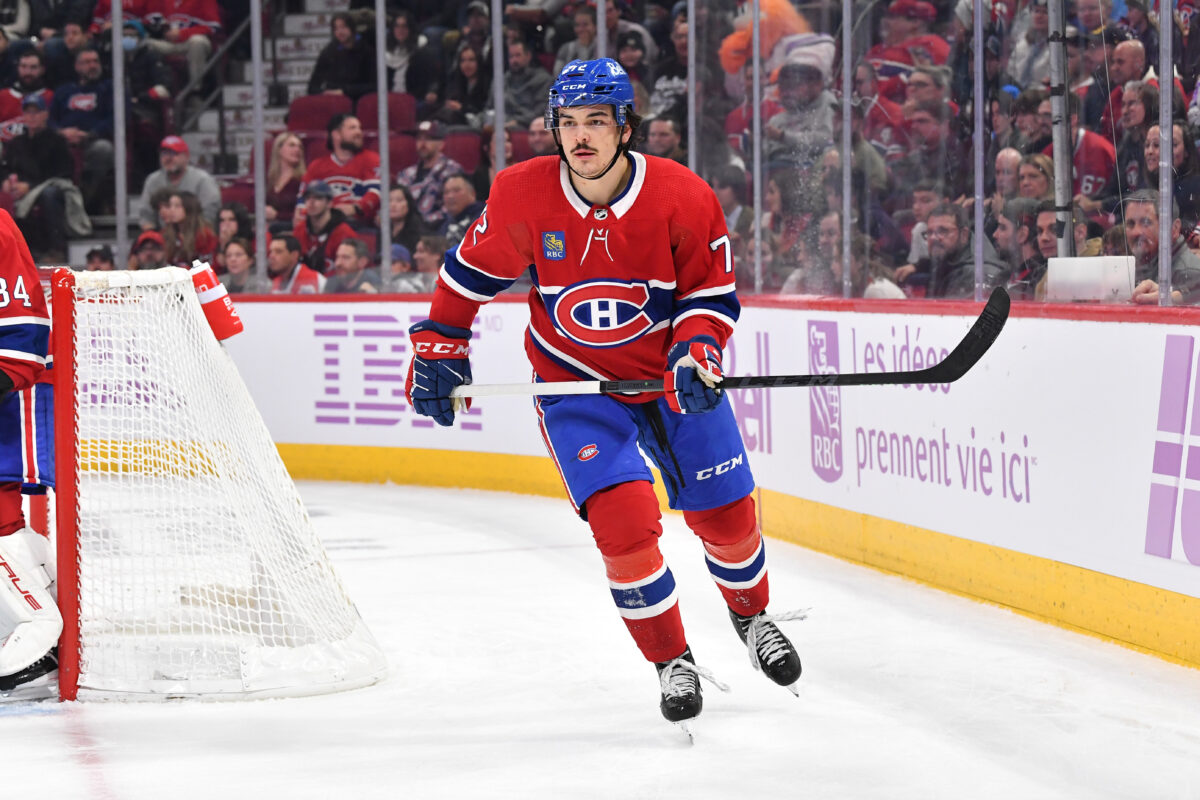As the Montreal Canadiens continue the rebuilding process, there is talk of what they lack. There are no disagreements about the fact Montreal needs to add an elite-level prospect to help push the rebuild to the next level.
However, there is not enough talk of what they do have on hand, and that is quality prospects that were found using later picks. There is no doubt that teams need star players to truly be Stanley Cup contenders, but another thing they need is depth. The later rounds of the NHL Entry draft are one area that general manager (GM) Kent Hughes will need to find both.
Depth is Key for Canadiens’ Success
A quick look at some of the recent Stanley Cup Championship lineups, and it’s easy to see how important it is to draft and develop not just the top prospects but also later-round players. For the 2020 and 2021 champs, the Tampa Bay Lightning, it took more than top two picks like Steven Stamkos or Victor Hedman. They needed quality play from later-round picks such as Brayden Point (2014 third round), Ondrej Palat (2011 seventh round), and Ross Colton (2016 fourth round). Those later picks were given time to develop before graduating into key roles on a winning team.

The Canadiens need to emulate successful blueprints, and Tampa Bay is one of several. Montreal will need to find the same riches from their later-round draft picks for them to become significant pieces. The Habs won’t be able to have every first-round pick become a legitimate NHL player, so they will need some surprises. Judging by the sheer number of draft picks that the Canadiens have had in the last four drafts and hold in the next two, they should be able to find more than one gem in the later rounds.
Canadiens Late Picks Having an Impact
Fans can see the beginnings of what will make the Canadiens a playoff-contending team. Improvements at five-on-five play, and a start to focus on their special teams’ issues are two big examples. As one area begins to see improvement, internal expectations and accountability increase. Head coach Martin St. Louis recently shared a metaphor for the growth of the team
“We’re farther ahead, last year we were like a baby. What you ask of a baby and what you ask a boy of seven or eight years old is different. The expectations are different. You need to take care of the baby. An older child is able to take on some responsibilities, whether it is brushing their teeth or making their bed. Now we’re in a different stage.”
Martin St. Louis
Part of the reason for the improvement is the development of players such as Nick Suzuki and Cole Caufield. However, improvement has also come from having depth players step into larger roles, and some of these depth players come from late picks or from scouting for undrafted players.
Latest THW Headlines
Related: Montreal Canadiens Injuries Provide Barron Opportunity to Develop
Arber Xhekaj, who was undrafted, is more than just someone who can fight and intimidate opponents. He has legitimate skills to add to his arsenal. Xhekaj has quickly become a reliable defensive player, capable of going against some of the league’s best forwards. He has also been used as a key piece of the penalty-killing units. He has poise with the puck on his stick, and his skating is much better than expected, as he moves well enough to keep pace with most opposing forwards in the league. He has also proven to be useful in the offensive zone with an ability to get shots through traffic onto the net that help generate rebounds or tip-ins. In the Ontario Hockey League (OHL), he was able to play 25 minutes or more per night, which bodes well for his NHL future as it shows he has the stamina to play the bottom-four minutes in the NHL.

Two more players, Raphael Harvey-Pinard and Jake Evans, both former seventh-round picks, have had an impact as well. Last season, Harvey-Pinard stepped into the lineup and scored 14 goals in 34 games. This season, he has been used on the top line. Yet, that won’t be the only role he plays this season, as he is a versatile player and can fit up and down the lineup. He’s a highly capable forechecker and has good offensive instincts. As for Evans, he has become a reliable bottom-six center. His ability to provide versatility as an energy player but also provide speed and offense helps to give St. Louis options and dependable depth.
Canadiens Prospect Pool Sleepers
The prospect pool is where the largest impact of the later-round selections can be seen. The potential is there to not only provide depth role players but also impact players. The first one that comes to everyone’s mind when thinking of the Canadiens picks is Lane Hutson. He was a later second-round pick in 2022 and slid because of his size. Now, he is seen as a potential Quinn Hughes type of defender as an offensively gifted player who may have issues defending against larger forwards, but the skills he provides more than compensate for that.
Staying on defense, there is a fourth-round selection from the 2023 draft who has the potential to become an impact defender as well, Bogdan Konyushkov. Hockey Hall of Famer Igor Larionov spoke highly of Konyushkov, saying he will become a key player for Montreal in the future. He was an unheralded pick because he was relatively unknown. The right-handed defenseman already plays over 22 minutes per night in the KHL for Torpedo Nizhny Novgorod and is a key member of their special teams. There have been only a handful of 20-year-olds in the KHL to have played a top defender’s role.
Yet the biggest impact may come from a Quebec-born player selected fifth-round pick in 2021, a hidden gem named Joshua Roy. He is a chameleon, capable of molding his game to suit his role. He was the offensive driver in the Quebec Major Junior Hockey League (QMJHL), then added a defensive side to his game and became a penalty killer. He has begun his American Hockey League (AHL) tenure on a tear, scoring five goals and 12 points in six games, averaging two points per game.
However, it was his play at the World Junior Championships as the ideal linemate for Connor Bedard that showcased his two-way game and puck retrieval skills. His development so far shows a player capable of becoming the ideal complimentary top-six player, one who would be the perfect fit on Montreal’s top line with Suzuki and Caufield.
There is no set blueprint on how to get skill in the later rounds, even though some teams do better at this than others. Recently, under Hughes, the Canadiens have been “swinging for the fences” by picking the skill players. He relies on his player development department to polish these gems into NHL players. Perhaps the selections are based on the type of player that fits a need or mental aptitude to thrive in the most difficult hockey market. One thing is clear, however, Montreal will not become a Stanley Cup contender overnight and will need a handful of later draft picks to become impact players if they ever do reach that level.
